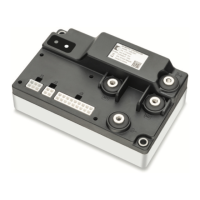2 — INSTALLATION AND WIRING
Curtis Model 1226 – September 2019
Return to TOC
pg. 26
Motor Temperature Sensor
e 1226 controller provides an input for a motor temperature sensor and can apply a limited
operating strategy (LOS) to prevent damage caused by overheating. e input measures the sensor’s
resistance, then uses the measured resistance to calculate the temperature.
e controller’s motor temperature function linearly cuts back the current from 100% to 0% when
the motor reaches the specied temperatures.
e controller supports the following types of motor temperature sensors:
• KTY83–122
• 2 KTY83–122 sensors, in series
• KTY84–130 or KTY84–150
• 2 KTY84–130 or KTY84–150 sensors, in series
• PT1000
To connect a motor temperature sensor input, use pin J1-6, which is associated with the Analog 5
and Switch 5 inputs.
Note: Analog 5 provides a circuit that supports an external temperature sensor input. Analog 5 is
typically used as the motor temperature sensor, but the input can be used for any external resistive
temperature sensor.
You enable and congure the motor temperature sensor with the parameters described in Motor
Temperature Control Menu on page 54.
Table 24 describes specications for the motor temperature sensor.
Table 24 Motor Temperature Sensor Specifications
Specication Value
Temperature Range –40°C to + 200°C
Analog Filter ~1 kHz
Resistance Measurement Range 250Ω – 5kΩ
Resistance Measurement Accuracy • ± 20Ω @ 2kΩ and below
• ± 100Ω @ above 2kΩ
Maximum sensor current 2.5mA
e following list describes temperature sensor considerations:
• e input is pulled high. If a switch conguration is required, the input must be congured
as a switch to B– (low active).
• e input should not be used as a voltage input due to the pull up load on the pin. e input
can be used as a resistance analog input.

